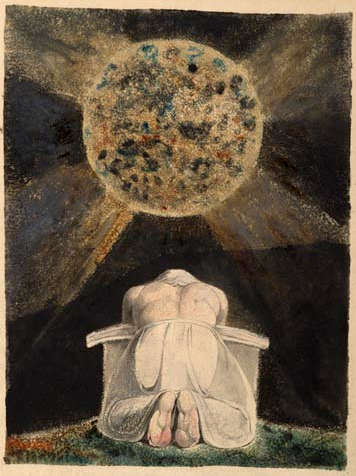Noticing that something exists, or sensing it, is an initial experience in the artistic process.
Inner voice / listening / collective unconscious
Piirto (2005: 9) discusses the cravings for silence that artists report, asserting that artists are seeking isolation in quiet places in order to hear an ‘inner voice’ that would inspire them to create.
The English Romantic William Blake was open in discussing his experiences of an inner voice, and took it as a matter of fact. Beer (2003: 12) quotes from a letter Blake wrote to John Flaxman in 1800 where Blake refers to the daily events of his time, adding that ‘My Angels have told me that…’ Blake (Halpern, 1994: xv) declared that he is under the guidance of angels day and night. Charles Taylor, in his study of the Sources of The Self, asserts (1989: 368-369) that the inner voice is a crucial concept in the work of the English Romantics, to the extent that fulfilling the inner voice makes the act of artistic creation possible (p. 374). According to Taylor, the hearing of an inner voice is at the same time the act in which the artist defines and formulates the inner voice, and thus realises it. In that way, Taylor (p. 375) wishes to emphasise that it is not a matter of copying a model or carrying out an already determined form, but rather one of actively crafting it, of giving a shape to the inner voice. The inner voice cannot be fully known outside or prior to the articulation and definition of it. Artists know it only once they do it, according to Taylor.
However, Kandinsky, in his work Concerning the Spiritual in Art (1972), saw the inner call from a different perspective. Kandinsky asserts that the inner voice is a source that calls upon artists to create. Kandinsky sees the function of the inner voice as an active source in itself that inspires or motivates artists into action. In that respect the inner voice should not be confused with thoughts that run in one’s mind and which one hears in one’s own voice. According to Jung (1990: 82), the inner voice is stronger than the individual to the effect that it is ‘The voice of all mankind resounds in us’.
If an inner voice comes from beyond the psyche of the artist, and actively calls upon the artist, then one should wonder how artists come to hear this inner voice. The act of listening is a challenging one, as author Deepak Chopra asserts. Chopra (1995) argues that often people do not listen but rather tend to prepare answers even before the other has finished talking. If ‘normal’ listening may prove so challenging, how then do artists seem to accomplish an inner listening?
Wordsworth’s work The Prelude II, from 1805 (1971: 326–330) gives some clues to the way in which the artist listens. Wordsworth says:
‘I would stand,
beneath some rock, listening to sounds that are
the ghostly language of the ancient earth,
or make their dim abode in distant winds.
Thence did I drink the visionary power.’
Wordsworth opens the description of this scene by saying, ‘I would stand’. That act of standing is not carried out for the purpose of resting after a long walk, but rather for the purpose of ‘listening to sounds’, as the following line in the poem says. Wordsworth reveals that he simply stops, standing still, in order to enable the faculty of listening to take place. While Wordsworth stands ‘beneath some rock’ in a natural landscape scene, what he hears is not the sound of the moment but rather the ‘language of the ancient earth’, asserting that even if looking at nature, it is a contemplative moment where one listens to an inner voice. Listening to the inner voice was an important issue in the times of Wordsworth, where there was a growing awareness that identity is created out of a human’s own mentality, and not out of a theological deity (Jay, 1984: 33). As the Romantic period freed itself from religious myths, Wordsworth, according to Jay (1984: 39–40), asserted that one should work from within oneself, not from external influences.
Blake’s work Sconfitta (fig. 11) illustrates this idea. In this work the figure Urizen is depicted in a deep contemplative scene in front of the new world that he has created. Urizen, although the creator of that world, does not look at his creation, but rather stops and reflects by drawing inwardly. The mental act of stopping allows artists to draw inwards. With attention drawn inwards, the artist gains access to the voice that dwells within.

Figure 11: William Blake, Sconfitta (1795, frontpiece illustration for Song of Los.) Image in public domain.
The first part of Yeats’s book A Vision (1974; first published in 1925), written together with his wife, explains their method of automatic-speech of drawing inward where they would gain access to an inner voice, or what they called the ‘communicators’.